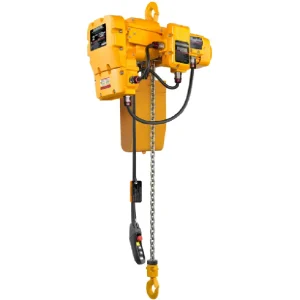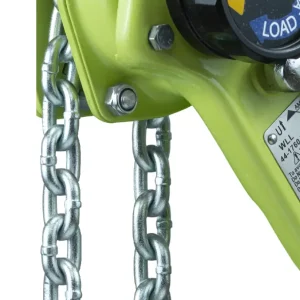With wireless technologies increasingly used throughout daily life, it naturally follows that they will also find a home in industrial applications as well. In the case of electric overhead traveling (EOT) cranes, replacing hard wired pendant controllers with wireless controls can enhance both safety and productivity. Whether used in manufacturing and material handling applications, it’s important to work through several key considerations when selecting wireless controls for overhead cranes.
Benefits of Wireless Controls for Overhead Cranes
Implementing wireless controls — specifically those using radio frequency (RF) signals to direct overhead crane movements and actions — offers numerous safety and productivity benefits.
“Because the controls are untethered from the crane, the operator can direct the equipment’s operation from a safe distance away,” said Andy Gray, Director of Sales at Scanreco, a member of ECMA. “This unrestricted movement allows the operator to walk freely around the load, as well as to see it from any angle. The enhanced visibility increases efficiency as well as reduces the risk of damage to the load, the crane, surrounding equipment, or facility structures.”
Additionally, today’s wireless controls can incorporate a broad range of safety functions, added Brett Schneider, Regional Sales Manager at HBC-radiomatic, a member of ECMA.
“Among them are the ability to restrict use of the device to authorized personnel only via individual access rights. The controls can be set with different functions enabled or disabled per user or scenario,” Schneider explained. “This limits less experienced operators to simpler moves. Or it can allow technicians operational access to the complete range of functions and features for crane maintenance purposes.”
Other safety features include push to operate functions, and automatic triggering of an E-stop to prevent unintended control activation should the load or remote drop suddenly.
To boost productivity, wireless controls for overhead cranes offer multiple efficiency enhancing features. They are highly intuitive, with joysticks, levers, or pushbuttons that respond immediately to operator actions. Some feature integrated video displays that show views from cameras mounted to the crane. Others offer message screens that clearly relay information about errors, faults, load weights, sway, and more. Today’s controls can also record and document all crane and hoist movements for later evaluation as part of training or an accident investigation.
Key Considerations When Selecting Wireless Controls
There are 10 factors to consider when evaluating and selecting a wireless control device and supplier for an overhead crane application. These include:
Obstructions in the Area
If the operations’ work envelopes have multiple obstructions at ground level, wireless controls are an ideal solution. These include building columns, other equipment or machinery, pallet racks and shelving, and more. Unlike pendant controls, wireless controls allow an operator to freely navigate around obstacles.
Line of Sight Between Transmitter and Receiver
Most wireless controls require a fairly consistent line of sight between the receiver placed on the overhead crane and the transmitter in the control unit. The distance between the two is an important detail to consider when evaluating device options.
Presence of Other Wireless Equipment
Because they use RF signals to transmit commands to the crane, wireless controls may experience interference from other RF technologies used in the operation. There are, however, different technologies available to mitigate that interference. Spread spectrum and frequency hopping technologies can overcome areas with a high likelihood of disturbance.
Configuration of the Crane
Many facilities have cranes configured with multiple girders and multiple hoists. Depending on the needs of the operation, a single wireless remote can operate several bridge cranes and hoists simultaneously. Likewise, multiple remotes can control different bridges and hoists on the same runway. Some operations use more than one remote, allowing two operators to safely “pitch and catch” or “catch and release” a bridge as it travels from one work zone to another. These configurations safely transfer the operating functions between devices, only allowing one to be in control of the equipment at a time.
Power and Wiring Requirements
When changing an existing crane system over from pendant to wireless controls, the overhead system’s distributed control network communication scheme is important to consider. Depending on the current power and wiring structure, connecting the receiver to the equipment may require different integration and programming approaches to successfully deploy wireless controls.
Use of Variable Frequency Drives
Overhead lifting equipment that incorporates variable frequency drives (VFDs) produces highly sensitive and responsive movement. Be sure to look for wireless control devices and suppliers who can translate that sensitivity into the controller to ensure the same one-to-one feel operators previously experienced.
Existence of Integrated Cameras
If cameras are present on the overhead crane, certain wireless controls can display their real-time video feed directly on an integrated display. These screens can also communicate different messages to operators about alerts, faults, errors, load weights, or other information associated with production processes.
Operator Preferences
Depending on what an operator is used to, wireless controls for overhead cranes can feature stepped or stepless levers or joysticks. Stepped controls help an operator interpret travel speed. Stepless controls create a one-to-one sensation that mimics the movement and responsiveness of variable frequency drives.
Manufacturing Standards
Not all wireless controls for overhead cranes are manufactured in the same way. However, those built to the standards set forth by the ANSI ECMA 15 Specifications for Cable-less Controls for Electric Overhead Traveling Cranes meet minimum requirements and guidelines for the design and function of these devices. Developed by the members of the Electrification and Controls Manufacturers Association (ECMA), this standard details design, operating, testing practices, and performance criteria that can be used to compare and select a supplier and device.
Housekeeping Strategies
It’s important to plan for day-to-day management of the wireless control device. As they are battery operated, they will need replacement (such as AA) or recharging — usually overnight. Additionally, designate a specific area to store the wireless control when it is not in use, so it is easy to locate when needed. Determine which operators have authorized access to use the unit and how to control that access. Finally, work with the supplier to develop a routine maintenance plan, as well as protocols for how to handle downtime and repairs should the device sustain damage.






